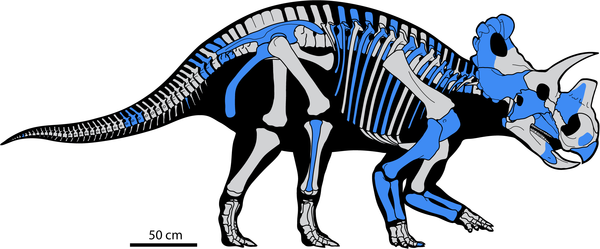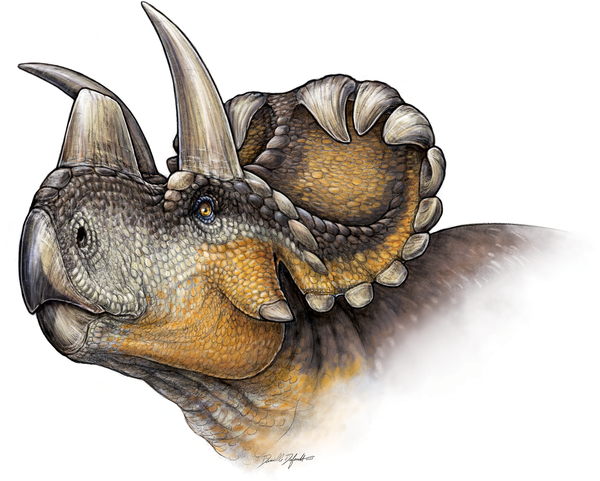Paleontologists say a dinosaur from 79 million years ago, known as Wendiceratops pinhornensis, could help them hook into the mysteries of how horned dinosaurs evolved.
The species’ somewhat whimsical name is inspired by the place where its fossilized bones were found (the Pinhorn Provincial Grazing Reserve in Alberta) and the person who found them (Canadian fossil hunter Wendy Sloboda) in 2010. But the lessons learned from the more than 200 bones recovered from the site are anything but whimsical.
The picture that emerges is of a 1-ton, 20-foot-long (6-meter-long) dinosaur that had a pair of horns sticking up from its brow, plus another horn on the nose. It also had a weird frill with hornlets that curled forward on themselves like hooks — which is apt for a dinosaur whose name evokes J.M. Barrie’s classic tale of Wendy, Peter Pan and Captain Hook.

Skeletal reconstruction of Wendiceratops pinhornensis gen. et sp. nov.
Elements represented in the material collected from the bonebed are indicated in blue.
That combination of characteristics hasn’t been seen in other species of that time and place — and it hints at a surprising level of diversity among horned dinosaurs, said Michael Ryan, a paleontologist at the Cleveland Museum of Natural History.
The variations in skull ornamentation suggest that the way horned dinosaurs used their heads played a big role in how they evolved. “That’s where all the evolution is happening in these animals,” Ryan said.

Life reconstruction of Wendiceratops pinhornensis gen. et sp. nov.
Illustration by Danielle Dufault.
Ryan and David Evans of the Royal Ontario Museum lay out the implications in a paper published Wednesday by the open-access journal PLOS ONE.
They say Wendiceratops appears to have been one of the first dinosaurs in its evolutionary line to have a prominent nasal horn. That suggests that such horns arose separately for two different branches of the dinosaur evolutionary tree — for the branch that includes Wendiceratops, and for the branch that includes the best-known horned dinosaur, Triceratops.
What’s more, Wendiceratops’ hooklike hornlets are similar to the frill ornaments seen in Sinoceratops, a Chinese horned dinosaur that lived about 72 million years ago. That suggests that Wendiceratops’ descendants may have migrated back from the Americas to Asia, Ryan said.
He said the different twists in the skulls of horned dinosaurs probably had to do with sexual signaling and head-butting competitions between the males of the species — analogous to what Bighorn sheep do today.
Whatever the reason, horned dinosaurs appear to have evolved more quickly than the norm for the Cretaceous Period. Ryan said vertebrate species usually arose, had their day and went extinct over a span of 2 million to 4 million years. “We’re finding that these horned dinosaurs replaced each other every half-million years,” he said.
There could be a lesson in that for modern times. Ryan noted that the era when Wendiceratops lived was marked by environmental change in North America, including warmer temperatures and the rise of the Western Interior Seaway.
“Maybe the rapid evolution we’re looking at is related to climate change,” Ryan said.
Ref: Evans DC, Ryan MJ (2015) Cranial Anatomy of Wendiceratops pinhornensis gen. et sp. nov., a Centrosaurine Ceratopsid (Dinosauria: Ornithischia) from the Oldman Formation (Campanian), Alberta, Canada, and the Evolution of Ceratopsid Nasal Ornamentation. PLoS ONE 10(7): e0130007. doi:10.1371/journal.pone.0130007
Editor: Peter Dodson, University of Pennsylvania, UNITED STATES



 July 9th, 2015
July 9th, 2015  Riffin
Riffin 

 Posted in
Posted in  Tags:
Tags: 